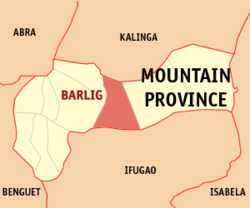Barlig Fialikia / Likaw-an | |
|---|---|
| Municipality of Barlig | |
 Barlig and surrounding rice terraces | |
 Map of Mountain Province with Barlig highlighted | |
 Interactive map of Barlig | |
Location within the Philippines | |
| Coordinates: 17°02′29″N121°05′58″E / 17.0414°N 121.0994°E | |
| Country | Philippines |
| Region | Cordillera Administrative Region |
| Province | Mountain Province |
| District | Lone district |
| Barangays | 11 (see Barangays) |
| Government | |
| • Type | Sangguniang Bayan |
| • Mayor | Clark C. Ngaya |
| • Vice Mayor | Delio F. Focad |
| • Representative | Maximo Y. Dalog Jr. |
| • Municipal Council | Members |
| • Electorate | 4,352 voters (2025) |
| Area | |
• Total | 228.64 km2 (88.28 sq mi) |
| Elevation | 1,837 m (6,027 ft) |
| Highest elevation | 2,689 m (8,822 ft) |
| Lowest elevation | 1,252 m (4,108 ft) |
| Population (2024 census) [3] | |
• Total | 4,363 |
| • Density | 19.08/km2 (49.42/sq mi) |
| • Households | 1,279 |
| Economy | |
| • Income class | 5th municipal income class |
| • Poverty incidence | 9.73 |
| • Revenue | ₱ 133.5 million (2022) |
| • Assets | ₱ 290.1 million (2022) |
| • Expenditure | ₱ 91.65 million (2022) |
| • Liabilities | ₱ 58.6 million (2022) |
| Service provider | |
| • Electricity | Mountain Province Electric Cooperative (MOPRECO) |
| Time zone | UTC+8 (PST) |
| ZIP code | 2623 |
| PSGC | |
| IDD : area code | +63 (0)74 |
| Native languages | Bontoc Balangao Ilocano Tagalog |
Barlig, officially the Municipality of Barlig (Filipino: Bayan ng Barlig, Ilocano: Ili ti Barlig) is a municipality in the province of Mountain Province, Philippines. According to the 2024 census, it has a population of 4,363 people. [5]


